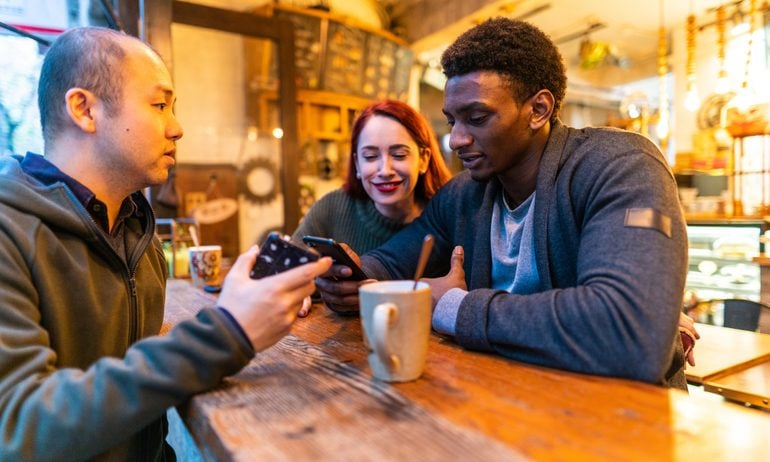Mobile Payment App Users Leave up to $316, on Average, in Apps

Many, or all, of the products featured on this page are from our advertising partners who compensate us when you take certain actions on our website or click to take an action on their website. However, this does not influence our evaluations. Our opinions are our own. Here is a list of our partners and here's how we make money.
Mobile payment apps are so commonplace that “Venmo” has become a verb. According to a new NerdWallet survey, 4 in 5 Americans (80%) use mobile payment apps, and 50% of Americans say they use these apps once a week or more often. Mobile payment app users have kept $316, on average, in their apps.
The survey of more than 2,000 U.S. adults — among whom 1,701 use mobile payment apps — conducted online by The Harris Poll, asked payment app users what they use apps for and whether they leave money in their apps instead of immediately transferring balances into their bank account. We also asked those who don’t use mobile payment apps why they opt out.
Key findings
Online shopping and paying back friends and family are top uses for mobile payment apps. The most common reason mobile payment app users use apps is to pay for an online purchase (50%), followed by paying back a friend (37%) or family member (35%) and paying bills (35%), according to the survey.
Many leave money in apps instead of immediately transferring it. More than two-thirds of mobile payment app users (68%) say they maintain a balance in their apps; app users keep up to $316, on average, in their payment apps instead of transferring it to their bank account, the survey found.
Many Americans who don’t use mobile payment apps cite security issues and lack of need. Nearly half of those who don’t use mobile payment apps (46%) say they don’t use them because they don’t trust the security of those apps, while 60% of non-app users are simply content with their current payment methods, according to the survey.
“Mobile payment apps can be a convenient, fast and easy way of sending money and paying for items,” says Elizabeth Ayoola, a personal finance expert at NerdWallet. “It’s essential that users of those apps understand the potential downsides of using these apps such as transaction fees and the risk of losing money if the mobile app isn’t federally insured.”
Mobile payment apps used for online shopping and repayment
Mobile payment apps are a popular way to pay when shopping online or paying back loved ones. Half of mobile payment app users (50%) say they use apps to pay for online purchases through a retailer, and many use mobile payment apps to pay back a friend (37%), family member (35%) or significant other (21%), according to the survey.
Some take mobile payments for their goods and services — 3 in 10 mobile payment app users (30%) say they use these apps to receive money for products or services they provide.
What you can do: Be wary of fees when using mobile payment apps
According to the survey, nearly 1 in 5 mobile payment app users (17%) say when they make a payment for a purchase of a good or service, they don’t designate it as a business transaction to avoid the fee for the seller. But plenty of app users are paying fees for the convenience of instant transfers and linking their credit cards.
Around a third of mobile payment apps users (33%) link their apps to a credit card, and nearly a quarter (24%) usually pay the fee to get instant transfers from the payment app to their bank account. Between credit card fees and transfer fees, these costs can add up.
“Some transactions are urgent and make paying fees for instant transfers worthwhile, while others can probably wait,” Ayoola says. “Although a few dollars may not seem like a huge deal, they’re dollars that could be distributed to your savings or recurring expenses.”
App users keep hundreds of dollars in mobile payment apps
Most mobile payment app users leave money sitting in their apps: Only about a third of users (32%) immediately transfer the money they receive via the app, the survey found. On average, mobile payment app users have kept $316 in their apps, with 18% of mobile payment app users saying they’ve kept $500 or more in their app before transferring it to their bank account.
What you can do: Transfer money out of apps right away
Mobile payment apps are convenient methods of payment, particularly when sending money to friends and family. However, the best way to use these apps is by linking them to your bank account and transferring money out of the apps as you receive it.
For about 1 in 7 Americans who don’t use mobile payment apps (14%), they say it’s because funds in the apps aren’t federally insured through the Federal Deposit Insurance Corp. FDIC insurance protects your money — up to $250,000 per depositor, per institution and per ownership category — if your bank fails. However, your money in a payment app probably doesn’t have this protection. And if the app fails, the Consumer Financial Protection Bureau warns, “your money is likely lost or tied up in a long bankruptcy process.”
“It’s easy to forget about cash in your mobile payment app, especially if you don’t need it urgently,” Ayoola says. “Since many of these payment apps aren’t federally insured, it’s ideal to protect your money by sending it to an account that is insured.”
Security concerns a major issue for those who don’t use apps
Of the Americans who don’t use mobile payment apps, nearly half (46%) say they don’t use them because they don’t trust the security of those apps, according to the survey. But the No. 1 reason for not using mobile payment apps is their contentment with their current payment methods, like cash and credit cards (60%).
Some Americans who don’t use mobile payment apps may be worried about scams: 10% of these non-app users say they don’t use them because they know someone who got scammed on a mobile payment app. It’s important to know how to spot these scams if you decide to use mobile payment apps.
What you can do: Understand the risks of sending money to the wrong person
Of Americans who don’t use mobile payment apps, 11% say it’s because they’re worried they’ll send money to someone they don’t know. That’s a valid concern; a small percentage (8%) of mobile payment app users say they’ve accidentally done this, the survey found. The risk here is that there’s no guarantee that you’ll get your money back in this scenario. You can ask the person who received the money to send it back, but they aren’t obligated to do so.
“I have made the mistake of sending money to the wrong person when sending cash with a mobile payment app, and it was an expensive mistake,” Ayoola says. “Before sending money, ask for a screenshot or picture of the person’s name on the app in question and verify one more time before you hit send. You could take it a step further by sending a small amount like 20 cents to ensure it goes to the right person before sending the full amount.”
Methodology
This survey was conducted online within the U.S. by The Harris Poll on behalf of NerdWallet from July 27-31, 2023, among 2,077 U.S. adults ages 18 and older, among whom 1,701 use mobile payment apps. The sampling precision of Harris online polls is measured by using a Bayesian credible interval. For this study, the sample data is accurate to within +/- 2.7 percentage points using a 95% confidence level. This credible interval will be wider among subsets of the surveyed population of interest. For complete survey methodology, including weighting variables and subgroup sample sizes, contact Mauricio Guitron at [email protected].
Disclaimer
NerdWallet disclaims, expressly and impliedly, all warranties of any kind, including those of merchantability and fitness for a particular purpose or whether the article’s information is accurate, reliable or free of errors. Use or reliance on this information is at your own risk, and its completeness and accuracy are not guaranteed. The contents in this article should not be relied upon or associated with the future performance of NerdWallet or any of its affiliates or subsidiaries. Statements that are not historical facts are forward-looking statements that involve risks and uncertainties as indicated by words such as “believes,” “expects,” “estimates,” “may,” “will,” “should” or “anticipates” or similar expressions. These forward-looking statements may materially differ from NerdWallet’s presentation of information to analysts and its actual operational and financial results.


